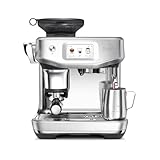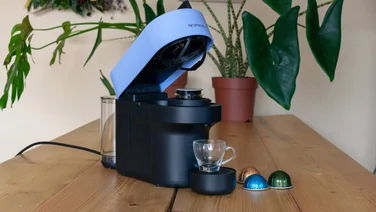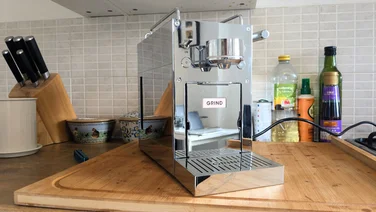To help us provide you with free impartial advice, we may earn a commission if you buy through links on our site. Learn more
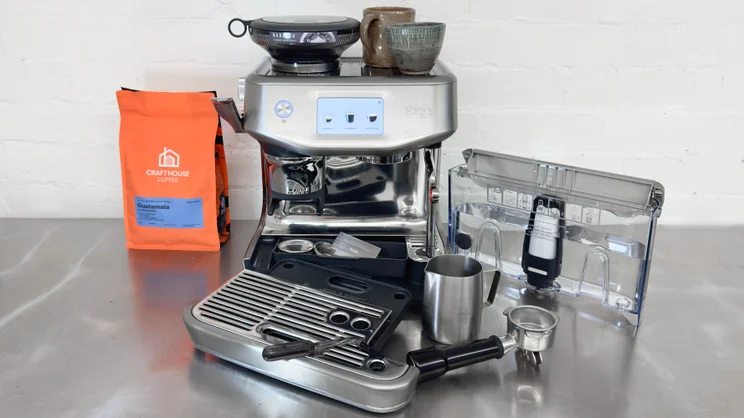
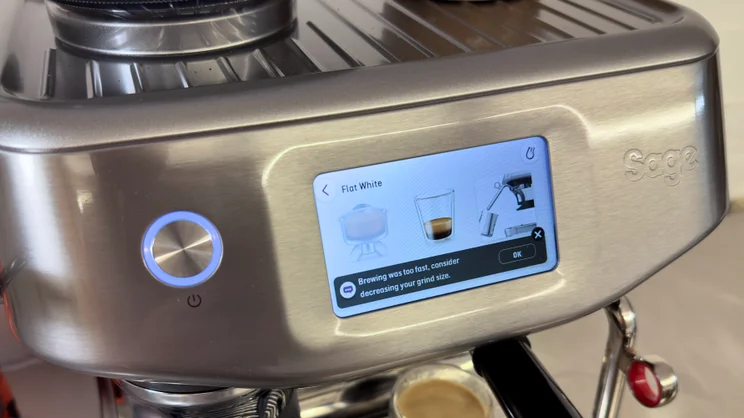
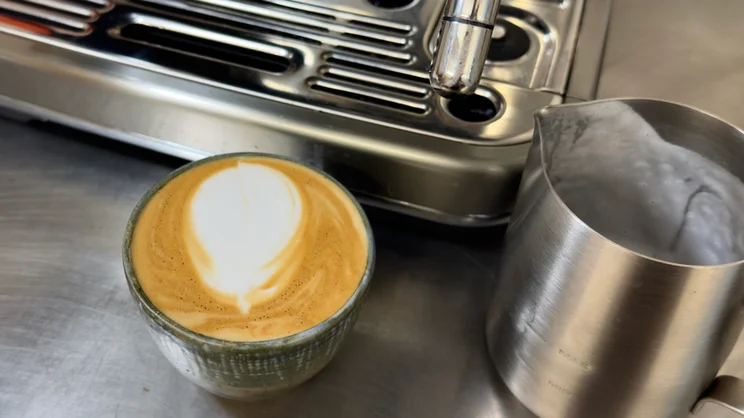
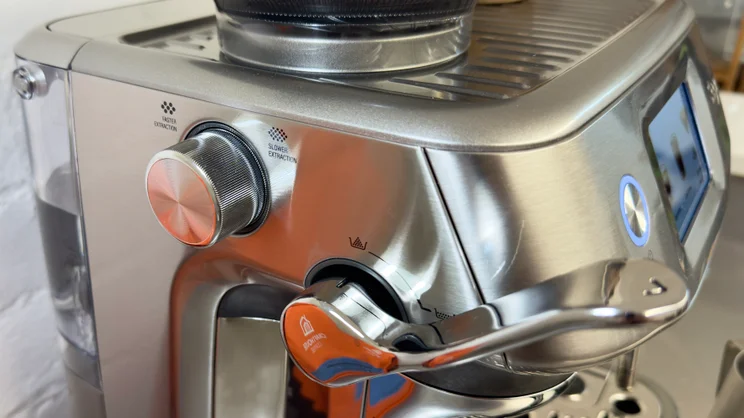
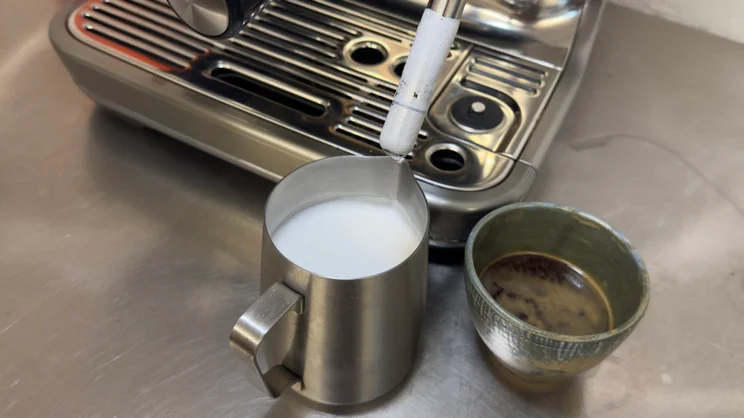
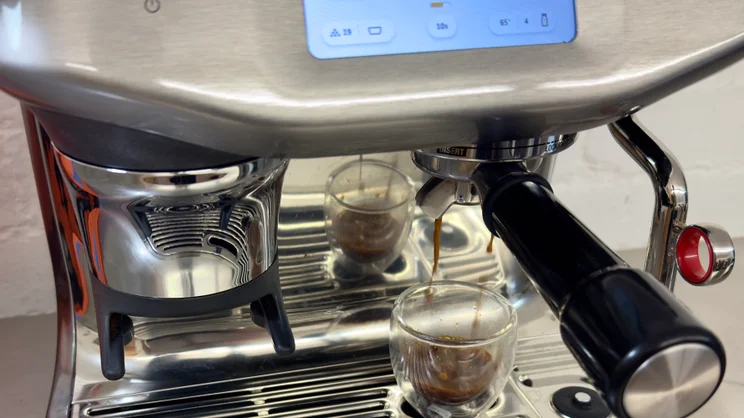
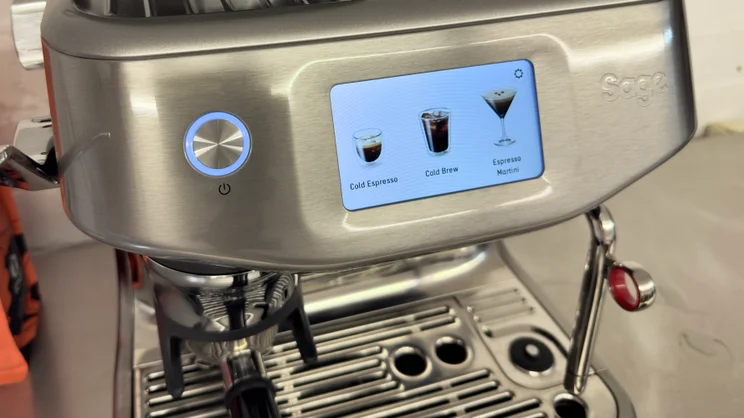
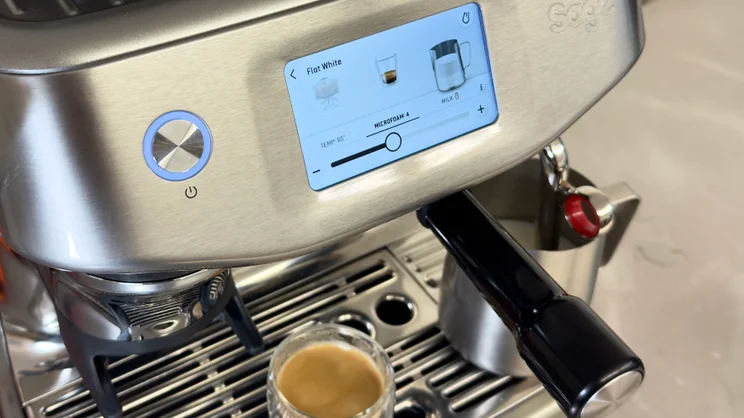
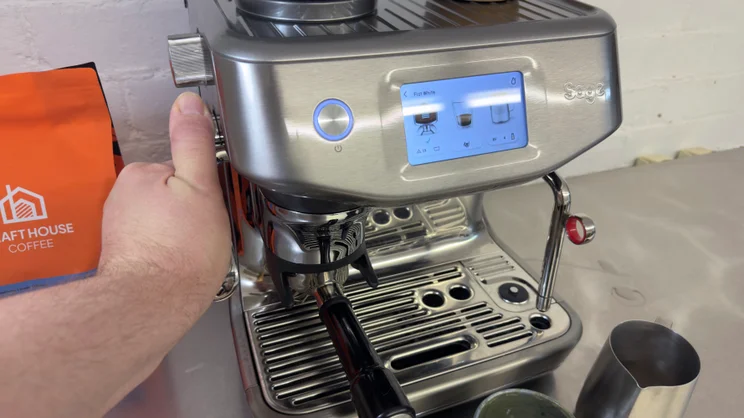
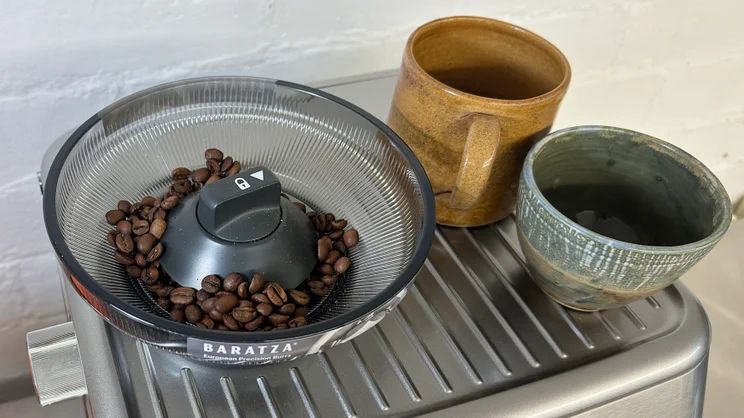
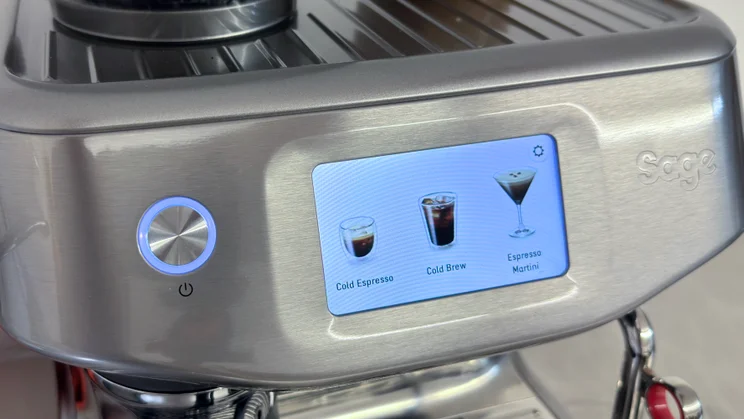
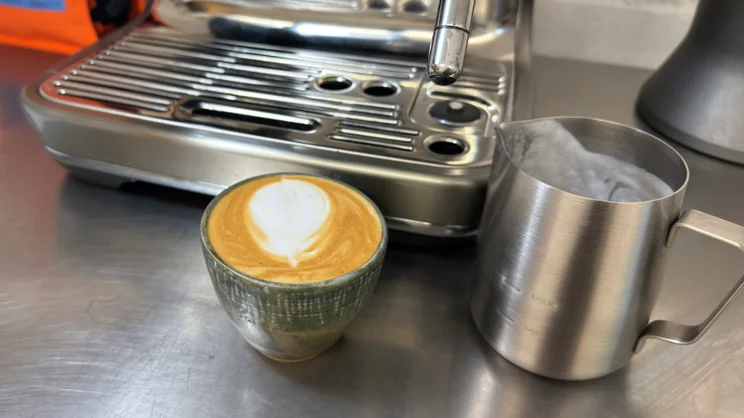
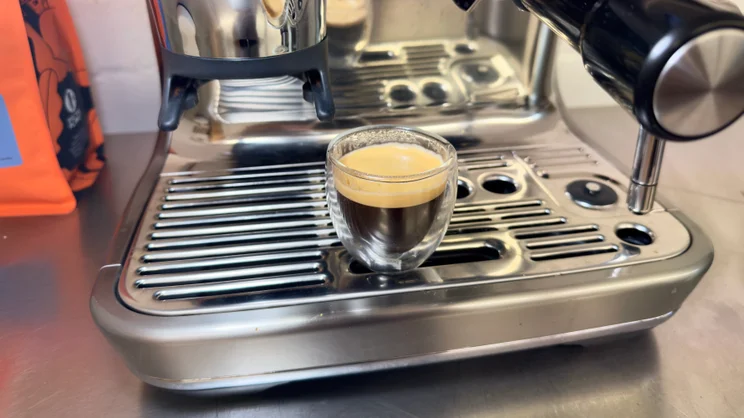
- Wide variety of hot and cold brews
- Superb results
- Easy to use
- Expensive
- Touchscreen is sluggish
Manual espresso machines can be a lot of work. The best results require patience, diligence and an eye for detail. If that sounds off putting, then you’ll be glad to hear that the Sage Barista Touch Impress with Cold Extraction is no ordinary espresso machine. This is one of the new breed of assisted machines that does all the hard work for you – grinding, measuring, tamping, brewing, and holding your hand every step of the way from coffee bean to cup.
Far from feeling like a button-pushing, bean-to-cup fraud, though, this is a machine that makes you feel like a budding barista. The process is a tactile, hands-on joy: pulling the large lever to tamp the coffee, slotting the portafilter into position, creating glimmers of latte art on your first freshly brewed cup. And the touchscreen coaches beginners step by step every step of the way.
This is the kind of machine that may make you wish you’d tried your hand at manual espresso a long, long time ago. And with 14 preset drinks types encompassing all the coffee staples, plus a variety of newly-added cold-brew coffee options, everyone in the household should be able to brew their preferred type of drink. Even if that happens to be an Espresso Martini.
Sage Barista Touch Impress: What do you get for the money?
All of Sage’s machines share a family resemblance, but if you’re wondering why this model looks nigh on identical to the previous model, that’s because it mostly is. With the old and new model side by side, it’s impossible to tell them apart. Delve deeper and you’ll note the firmware is different and some tweaks have been made to the touchscreen interface. You may possibly hear the difference, as well, as we’ll discuss later – but it remains a good-looking, solidly-built machine.
To be fair, Sage didn’t need to go back to the drawing board. The design evokes the silhouette of professional manual espresso machines, and Sage’s designers have done a great job of making it kitchen-friendly.













It’s reasonably compact, at 36 x 34 x 41.5cm (WDH) and, importantly, you can pick your preferred colour from a strictly monochrome palette, ranging from light silver to black. Sage gives you the option of pale Sea Salt silver, Brushed Stainless Steel (slightly darker silver), Black Stainless Steel and matte Black Truffle.
Build quality is good, if not mind-blowing given the four-figure price. It’s cast in a mixture of nice-feeling plastics and metal, all of which slot together with reassuring solidity. You could sensibly argue that it doesn’t feel like a machine that costs twice as much as the Ninja Cafe Luxe ES601 (£550), but is it a step up? Subjectively speaking, I’d say so.
At first glance, a few of the key features stand out. Centre stage, the usual panel of buttons and knobs are replaced with a bright, colourful touchscreen. The bean hopper on top flares out like a chef’s toque and holds up to 340g of beans – the UV-tinted plastic and rubber seal help to retain freshness. And on the left-hand side, a large silver lever reveals the presence of Sage’s Impress Puck system which takes care of all the dosing and tamping duties.













Some features aren’t so obvious, however. The new cold extraction features don’t make themselves known until you start scrolling through the touch interface, for instance, and the only reason you’ll know about the fancy Baratza grinder burrs is because of the sticker attached to the hopper. It’s a welcome upgrade over and above cheaper models in Sage’s range, though, as it uses the same burrs found in Baratza’s excellent standalone grinder, the £160 Encore ESP.
As ever, Sage bundles the machine with all the accessories you could ask for and it’s good to find pressurised and non-pressurised baskets in both single and double sizes in the box. I’d always recommend using the unpressurised double baskets in tandem with freshly roasted beans for the best results, but the non-pressurised baskets give you the latitude to use pre-ground supermarket coffee and still get a fairly decent looking espresso out of it.













There’s also a 480ml stainless steel milk jug, a tool for clearing steam wand blockages, Sage’s handy Razor tool for trimming over-full portafilters, and a brush for cleaning the grinder and various crevices. There’s also a rubber blanking disc, which you can slot into the portafilter for backflushing – an essential part of cleaning. Speaking of which, there’s also a handful of cleaning and descaling products in the box.
Sage supplies a single ClaroSwiss water filter in the box, and this is good for around three months or 40 litres of filtration. Replacements cost a fairly steep £15 each, though, so you may want to budget for a water filter jug instead.
What’s it like to use?
Turn on the machine and it’s ready to go in around five seconds. A few prods of the touchscreen. Two pulls of the lever. A lazy thrust of the portafilter. Some milk splashed in the jug. Press the touchscreen again. Combine the coffee and milk. Suddenly, despite your bleary eyes and sleep crumpled face, you’ve become the barista.
At least 80% of the hassle with manual espresso is balancing all the various factors – the grind size, dosage, brew volume, temperature – and always wondering if tweaking something might get you a better cup. By contrast, the Sage Barista Touch Impress relieves that paranoia; it stops you doubting whether it’s even worth starting the process, as you know you’ll get good results every time.













There is still a small learning curve here for complete novices but the touchscreen does a good job of leading users through the setup process. On first use it leads you through testing your water hardness so the machine knows how often to prompt you to descale, and it provides a tour of the machine, showing you how to remove the drip tray – revealing the hidden accessory door behind it. Naturally, you’re also given a step-by-step guide on how to brew your first coffee.
The brewing process works well. Dab the grind button, wait for it to finish and pull the lever. If more coffee is required to reach the optimal volume, it’ll prompt you to tap the screen to add a bit more and tamp again. That done, you simply brush off any excess grounds from the portafilter’s ears and lock it into place.













Press the drinks icon, and the pump thrums into life while an onscreen timer starts ticking. If the shot time is in the right ballpark – around 20 to 30 seconds – then you can move on to the milk frothing – or the drinking, if you prefer black coffee. If it detects that the shot is pouring too fast or slow, a little tooltip appears on the bottom of the screen and advises you to increase or decrease the grind size accordingly.
This new version of the Barista Touch Impress takes everything I liked about the original and adds cold brew coffee extraction. Frankly, I wonder if this might have been possible with a firmware upgrade – sadly there’s no Wi-Fi or Bluetooth connectivity to make this possible – but it’s worth noting that this new model is significantly noisier, so I suspect there have also been some changes under the bonnet.
Indeed, where the old model’s pump had more of a low pitched thrum, this new version has a more high-pitched rasp. It’s far more intrusive, but I’m guessing it may be a necessary evil given the new cold extraction features.













One practical word of advice is to leave a decent amount of space around the machine. While the 2-litre water tank at the rear is removable, you’ll need a little room to manoeuvre the tank out. It is possible to top it up without physically carrying it to the sink, as there’s a hinged lid (and a useful integrated handle), but you’re more likely to spill water on the top panel or onto the bean hopper, which is a no-no. And, similarly, you’ll need a little bit of clearance above the machine to be able to refill the beans when required. Resist the temptation to squeeze it into the smallest space possible.
When it comes to replacing the beans, you can either delve into the menus and use the Intelligent Setup wizard to dial in the grind and dosage settings, or alternatively you can just hit the brew button and hope, and the machine will advise you to adjust the grind size if shots are pouring too quickly or too slowly.
For anyone who’s used a fully manual machine and separate grinder, this is a massive boon. There is a deep joy to the fully manual process, but when you just want a coffee, the rigmarole of grinding, weighing, tamping, brewing, weighing, tasting and repeating the process every time you get a new bag of beans is definitely our least favourite kind of grind.
What’s the coffee like?
The coffee this machine produces is consistently great. All the standard recipes work well, and the cold extraction is a really interesting addition. Given that I’m typing this review in the midst of a particularly toasty UK heatwave, I’ve been loving the option of cold or over-ice coffee.
With espresso forming the base of several drinks, it’s reassuring to find that the Barista Touch Impress brews a very refined cup with little effort. I used Craft House Coffee’s medium light roast Ethiopian single origin beans, which I’ve been drinking for the last few weeks in both filter and various espresso machines, and the Sage delivered great results. For these beans, the dosage reached a sensible 19g in the double basket. Bear in mind, though, that this will vary depending on the roast and bean as the Sage’s automatic dosing is volume- rather than weight-based.
With that kind of dosage, the Sage brewed around 50g of espresso, which works out at a 2.5:1 ratio. This is sensible: higher ratios tend to work well for most medium to medium light roasts, while lower ratios give a better balanced cup with darker roasts. Given that the fashion for most modern roasters is to stay in that light to medium roast zone, this is a sensible choice.













Numbers aside, it’s taste that matters and this is consistently excellent. There was no excess sourness or bitterness, just a hugely fruity, intense cup of espresso. That said, it’s easy to dial the grind size up or down a notch or two to subtly adjust the flavour to your liking. Some beans may benefit from a quicker or slower extraction, so you can just trust your taste buds and tweak as necessary.
I feel like the Impress Puck System does wonders for consistency here. Press the lever – ideally twice – and it tamps down the coffee with a perfectly even 10kg of force time after time. I’m not saying that manual tamping is particularly challenging, but it is tricky to be 100% consistent, and taking this element out of the equation makes it just that tad easier to get consistent results.
It’s good to find a dedicated hot water spout. Dab the tiny onscreen button (we’ll moan about how small it is shortly) and a stream of hot water fires into your cup. As it pours at an angle, it’s essential to position taller cups carefully if you don’t want any spills. And the flow rate is rather slow: if you want to top up a full mug, it’ll take a while.













The automatic milk frothing is excellent. You can set the machine to default to your preferred type of milk – dairy, almond, oat and soy – and it’s easy to switch modes to and fro when required. The target temperature defaults to 65℃, but you can adjust from 45℃ to 75℃ in five-degree increments. You can also select the amount of froth from eight preset levels – it defaults to setting 4. I tested it with dairy and Oatly Barista oat milk, and the results were good with both. Dairy was a better consistency for latte art, though.
I’ve seen some reviewers complain that the results with dairy milk were poor, but that’s not my experience. I tested both the new and old Barista Touch Impress models side by side and the results were identical – and identically good. A quick tap of the jug to clear a handful of bubbles and a little swirl was all it took to create a perfectly smooth, paint-like microfoam.
You can steam milk manually, but given how good and consistent the automatic mode is, there’s little point in my opinion. It’s also a tad awkward because the steam wand isn’t on a ball joint and there isn’t a physical tap to turn the steam on and off – you have to prod the touchscreen to start and stop, and the wand only moves back and forth.
What could be better?
The interface isn’t always completely intuitive. In some instances, it isn’t always obvious that you need to press the onscreen images as they don’t look like clickable icons. It’s fine once you get used to it, but it may take less techy users a while to learn the ropes.
One other issue with the appliance is that the position and size of the hot water and manual steam buttons is less than ideal. They’re way too small and squished up hard alongside the touchscreen’s bezel which can make them awkward to press. These are relatively minor moans, though: once you’ve got used to the interface, it’s easy to get around. And it’s arguably easier to use than rival machines such as the Ninja Cafe Luxe ES601 with its panel filled with rows of similar-looking buttons and LED lights.













One more serious criticism is that the touch interface isn’t as silky smooth as it should be. Whereas the pricier Sage Oracle Jet feels snappy and responsive, the Barista Touch Impress’ hardware could do with an upgrade. It’s usable, but the jerkiness seems out of place given the premium price. Sage needs to address this for the next hardware upgrade.
It’s also mildly disappointing that there is no Wi-Fi or Bluetooth connectivity. And not because of the pointless remote control features found on some coffee machines, but for the option of future firmware updates and subtle operational or usability improvements. At this price, some level of upgradability would seem sensible.
One final tiny complaint we’ve seen levelled at the Barista Touch Impress is the lack of cold milk frothing. Rival machines such as the Ninja Cafe Luxe ES601 achieve this with a spinning frother in the bottom of the milk jug. This presents some design limitations, however, and frankly there’s little difference between this and a cheap handheld spinning milk frother, which you can pick up on Amazon for around £5.
Barista Touch Impress: Should you buy it?
If you’ve found yourself sitting in your local independent coffee shop, wishing you could replicate the trained barista’s efforts at home with a fraction of the skill or effort, then Sage has answered your prayers.
This still isn’t a machine for the terminally impatient. A simple capsule machine is still far less faff. And equally, an automatic bean to cup machine will deliver decent results with less effort. Be in no doubt, though: even if you spend twice as much again on an automatic bean to cup machine, the results won’t come close to the Sage.
Is it overpriced? Yes. Is it brilliant? Yes. If you can afford it, the Barista Touch Impress may just convince you it was worth every penny.
